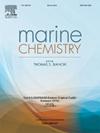Investigation of open ocean ammonium aerosol sources in the North Pacific Ocean (Oahu, Hawaii)
IF 2.5
3区 地球科学
Q2 CHEMISTRY, MULTIDISCIPLINARY
引用次数: 0
Abstract
Anthropogenic nitrogen (N) deposition entering the ocean from the atmosphere has increased over time. Ammonia (NH3), a precursor to ammonium (NH4+), is released into the atmosphere via both natural sources (e.g., ammonification, biomass burning, waste products, surface ocean emissions) and anthropogenic sources (e.g., agriculture, industry, sewage, vehicle emissions). Studies disagree on the quantity of anthropogenic N deposition to the ocean, as well as the consequences this excess N poses to the biogeochemistry of the open ocean, particularly in the Pacific Ocean. Understanding the current role that the open ocean is playing in the N cycle and budget is essential to determine the sources of N (e.g., internal or external, recycled or excess) and to further distinguish the relationships between atmospheric and oceanic N. Therefore, in the current study, ion concentrations and ammonium isotope values (δ15N-NH4+) were measured for aerosol samples collected on the coast of Oahu, Hawaii from 2021 to 2022 (n = 67). This location was chosen based on low anthropogenic activity, access to the open ocean, and the premise of a dominant marine signal. Particulate NH4+ concentrations ([NH4+]) averaged 3.7 ± 7.3 ng/m3, with no distinct seasonality (p > 0.05). The δ15N-NH4+ values also did not exhibit distinct seasonality (p > 0.05), but did fall into three unique clusters (using a K-means clustering analysis): cluster one = 19.0 ± 3.9 ‰ (n = 8), cluster two = 4.1 ± 2.3 ‰ (n = 31), and cluster three = −3.3 ± 2.4 ‰ (n = 13). Cluster three was best explained as an ocean emissions signature, which was determined via a phase partitioning model that incorporated N isotope fractionation associated with NH3 conversion to NH4+. Cluster one had higher than average [NH4+] along with air mass origins from two seabird sanctuaries and was hypothesized to be a seabird emission signature. Cluster two was considered a mix of these two sources (67 % marine, 33 % seabird emissions). 6 % of aerosol inorganic N (NH4+ + nitrate; annual dry inorganic N = 5.5 ng/m3) is from [NH4+], with 35 % resulting from seabird emissions. The annual inorganic N (IN; NO3− + NH4+) dry deposition value for this site was 1.2 ± 1.1 Tg N·y−1.
北太平洋(夏威夷瓦胡岛)开阔海域铵态气溶胶源调查
随着时间的推移,从大气进入海洋的人为氮(N)沉积有所增加。氨(NH3)是铵(NH4+)的前体,通过自然来源(如氨化作用、生物质燃烧、废物、海洋表面排放)和人为来源(如农业、工业、污水、车辆排放)释放到大气中。关于人为氮沉积到海洋的数量,以及这种过量的氮对开放海洋,特别是太平洋的生物地球化学造成的后果,研究意见不一。了解开放海洋目前在N循环和收支中所起的作用,对于确定N的来源(例如,内部或外部,再循环或过剩)以及进一步区分大气和海洋N之间的关系至关重要。因此,在目前的研究中,对2021年至2022年在夏威夷瓦胡岛海岸收集的气溶胶样本(N = 67)进行了离子浓度和铵同位素值(δ15N-NH4+)的测量。这个地点的选择是基于低人为活动,进入开阔的海洋,以及海洋信号占主导地位的前提。颗粒NH4+浓度([NH4+])平均为3.7±7.3 ng/m3,无明显的季节性(p >;0.05)。δ15N-NH4+值也没有明显的季节性(p >;0.05),但确实属于三个独特的聚类(使用K-means聚类分析):聚类1 = 19.0±3.9‰(n = 8),聚类2 = 4.1±2.3‰(n = 31),聚类3 =−3.3±2.4‰(n = 13)。聚类3最好解释为海洋排放特征,这是通过相分配模型确定的,该模型包含了与NH3转化为NH4+相关的N同位素分馏。集群1的[NH4+]含量高于平均水平,并且来自两个海鸟保护区的气团也高于平均水平,并被假设为海鸟排放的特征。第二组被认为是这两种来源的混合(67%来自海洋,33%来自海鸟)。6%的气溶胶无机N (NH4+ +)硝酸盐;年干无机N = 5.5 ng/m3)来自[NH4+], 35%来自海鸟排放。年无机氮(IN;NO3−+ NH4+)干沉积值为1.2±1.1 Tg N·y−1。
本文章由计算机程序翻译,如有差异,请以英文原文为准。
求助全文
约1分钟内获得全文
求助全文
来源期刊

Marine Chemistry
化学-海洋学
CiteScore
6.00
自引率
3.30%
发文量
70
审稿时长
4.5 months
期刊介绍:
Marine Chemistry is an international medium for the publication of original studies and occasional reviews in the field of chemistry in the marine environment, with emphasis on the dynamic approach. The journal endeavours to cover all aspects, from chemical processes to theoretical and experimental work, and, by providing a central channel of communication, to speed the flow of information in this relatively new and rapidly expanding discipline.
 求助内容:
求助内容: 应助结果提醒方式:
应助结果提醒方式:


